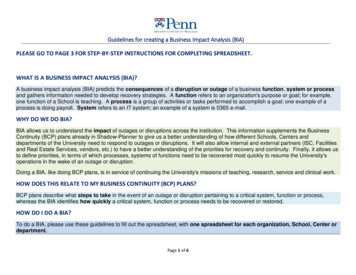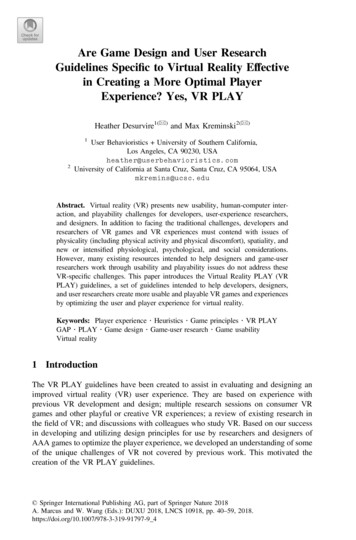
Transcription
Guidelines for creating a Business Impact Analysis (BIA)PLEASE GO TO PAGE 3 FOR STEP-BY-STEP INSTRUCTIONS FOR COMPLETING SPREADSHEET.WHAT IS A BUSINESS IMPACT ANALYSIS (BIA)?A business impact analysis (BIA) predicts the consequences of a disruption or outage of a business function, system or processand gathers information needed to develop recovery strategies. A function refers to an organization's purpose or goal; for example,one function of a School is teaching. A process is a group of activities or tasks performed to accomplish a goal; one example of aprocess is doing payroll. System refers to an IT system; an example of a system is 0365 e-mail.WHY DO WE DO BIA?BIA allows us to understand the impact of outages or disruptions across the institution. This information supplements the BusinessContinuity (BCP) plans already in Shadow-Planner to give us a better understanding of how different Schools, Centers anddepartments of the University need to respond to outages or disruptions. It will also allow internal and external partners (ISC, Facilitiesand Real Estate Services, vendors, etc.) to have a better understanding of the priorities for recovery and continuity. Finally, it allows usto define priorities, in terms of which processes, systems of functions need to be recovered most quickly to resume the University'soperations in the wake of an outage or disruption.Doing a BIA, like doing BCP plans, is in service of continuing the University's missions of teaching, research, service and clinical work.HOW DOES THIS RELATE TO MY BUSINESS CONTINUITY (BCP) PLANS?BCP plans describe what steps to take in the event of an outage or disruption pertaining to a critical system, function or process,whereas the BIA identifies how quickly a critical system, function or process needs to be recovered or restored.HOW DO I DO A BIA?To do a BIA, please use these guidelines to fill out the spreadsheet, with one spreadsheet for each organization, School, Center ordepartment.Page 1 of 6
Guidelines for creating a Business Impact Analysis (BIA)WHAT'S NEW IN DOING A BIA?Two new items in the BIA are the Recovery Time Objective (RTO) and Recovery Point Objective (RPO). The RTO asks thequestion: how long can we go without this process or system being in place? The RPO asks the question: how much data can weafford to lose in an outage to this system or process? For example, if you can stand to lose a day's worth of e-mail due to an outage,your RPO is 1 day. If you cannot stand to lose any e-mail due to an outage, your RPO is 0. NOTE: RPO only applies to IT only.You may wish to assemble your tabletop exercise team and obtain their input in completing the spreadsheet.Once you've completed the spreadsheet, please send it to askmc@lists.upenn.edu. The central Mission Continuity Program (MCP)leadership will load the information into Shadow-Planner for you. Once the information is loaded, you can report it out from ShadowPlanner to review it and determine how you may want to update it.Below are guidelines for updating BIAs once they are in Shadow-Planner.Questions? Contact the Mission Continuity Program (MCP) at askmc@lists.upenn.edu.Page 2 of 6
Guidelines for creating a Business Impact Analysis (BIA) To create a BIA, follow the steps below to complete the BIA spreadsheet.Once the spreadsheet is completed, please submit it to askmc@lists.upenn.edu.The central Mission Continuity Program (MCP) leadership will load the information into Shadow-Planner.Once the information is stored in Shadow-Planner, you may use the update guidelines to keep your BIA information up-to-date.Step#1ColumnletterColumn title2BOrganization3CLocation4DPlan type5EMission type6FProcess typeInstructionsOpen the spreadsheet, located on the MCPwebsite here.From this drop-down list, select the name ofyour organization.From this drop-down list, select the location ofyour organization.NotesItems in the drop-down list include: Main campus, NewBolton Center, Morris Arboretum, Wharton West,Pennovation, Other.For off-site clinical practices, use Other.7GThis column is already populated as: BusinessImpact Analysis.From this drop-down list, select the part of theUniversity's mission this process supports.The data is organized into the BETH3 model(also used for BC Planning Actions Plans).Process name Select the most critical processes yourorganization is responsible for within eachProcess Type.Page 3 of 6Items in the drop-down list include:Education/Teaching, Research, Service, Clinical andOperations/Admin.Items in the drop-down list include: Buildings,Equipment, Technology, Human Resources and 3rd-partyvendors/partners.NOTE: Human Resources, in addition to faculty, staffand students, includes human subjects and patients.Equipment includes animals and specimens.A Process may be something your organization does,like a function, or an IT system. Examples include: Fora School, a critical Process under Teaching might be
Guidelines for creating a Business Impact Analysis (BIA)Step#ColumnletterColumn titleInstructionsNotesUndergraduate instruction. For the Registrar's Office,a critical process under Technology might be thePennant system.For each Process Type, you may enter as manyprocesses as you think are critical. If you choose touse more than 4, you can add an additional row in thespreadsheet in the appropriate location.8HProcessoverviewEnter a one-sentence description of what theprocess, function or system does.9I10JProcessownerBAU locationWho is/are responsible for ensuring theprocess runs properly?Where is the process usually t are the business hours of theorganization that owns the process or system?Approximately how many FTEs are involved inconducting the process on a business-asusual basis?13MBusinesspeaksFrom the drop-down list, select the item thatdescribes any peak times for this process.Page 4 of 6If you have a Mission Continuity plan created for aspecific element in the BETH3 model, it's wise to have aprocess in the BIA for it also.For example, "Provide instruction to undergraduate,professional and doctoral students." Or "Store allstudent academic information and allow students toregister for classes."This may be one person's name or the name of a group,Department, Division, etc.BAU stands for "Business As Usual." For example,"Franklin Building," or "Huntsman Hall."For example, could be 9AM – 5 PM, Mon-Fri.Under normal conditions, the total calculation ofFTEs needed to fulfill or conduct this process. Forexample, if two people normally each spend 75% of theirtime on this process or function, the FTE would be 1.5.Determine if there are times of week, month or yearwhen your organization is busier than usual conductingthis process. Examples include: move-in,Commencement, payroll processing.
Guidelines for creating a Business Impact Analysis (BIA)Step#ColumnletterColumn titleInstructionsNotes14NProcessavailabilityWhen is the process usually available orconducted?15OBreadth ofimpact16P17QDate lasttestedRecoverylocationHow widely does the process impact theUniversity, the health system and/or thecommunity?Date of your last tabletop yPointObjective(RPO)ITDependenciesIf the process/system needs to be recovered ina different place, what is that? If it's not adifferent place, enter, "Same location".The Recovery Time Objective (RTO): howlong can we go without this process or systembeing in place?The Recovery Point Objective (RPO): howmuch data can we afford to lose in an outageto this system or process?List the most critical IT systems on which thisprocess depends.Page 5 of 6Items in the drop-down list include: specific day ofweek, specific time of month, specific time of year,more than 1 of these, none of these.For example, could be Mondays of every week, or everyyear in May, or from 2-5 PM every day.Items in the drop-down list include: Department only,Organization-wide, School/Center-wide, Universitywide, Community impact, UPHS & University.Select from drop-down: less than 1 hour, up to 4hours, up to 1 day, up to 3 days, up to 1 week, greaterthan 1 weekFor example, if you can stand to lose a day's worth of email due to an outage, your RPO is 1 day. If you cannotstand to lose any e-mail due to an outage, your RPO is0. NOTE: This applies to IT only.Select from drop-down: less than 1 hour, up to 4hours, up to 1 day, up to 3 days, up to 1 week, greaterthan 1 weekThis could be a centrally maintained system, or a systemthat is maintained just for your organization. Forexample, if the process is student course registration, itdepends on the Pennant system. Examples of some ofthe most-used central systems include: BEN, Box,PennNet, 0365 e-mail, PennWorks/Payroll.
Guidelines for creating a Business Impact Analysis (BIA)Step#21ColumnletterUColumn titleLifeDependenciesInstructionsNotesOPTIONAL: If the process involves livingbeings, specimens or plants, please use thedrop-down to select the appropriate item.Page 6 of 6List no more than 10 dependencies for each process orsystem.Items in drop-down list include: Human subjects,Animals, Specimens, More than 1 of these, None ofthese.
Guidelines for creating a Business Impact Analysis (BIA) Page 3 of 6 To create a BIA, follow the steps below to complete the BIA spreadsheet. Once the spreadsheet is completed, please submit it to askmc@lists.upenn.edu. The central Mission Continuity Program (MCP)










